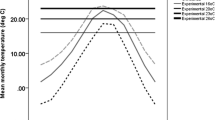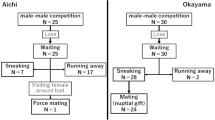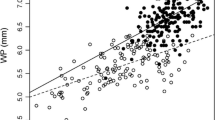Abstract
Drosophila melanogaster males defend food against other males to increase their access to females on food. The territorial behavior of stocks collected from Townsville, Corindi, and Melbourne on the east coast of Australia were compared. Males from these stocks showed the same incidence of territorial encounters. However, Melbourne males were more successful at obtaining territories in competition with Townsville or Corindi males. This difference could be accounted for largely by variation in body weight, although territorial success was also determined by other factors because Townsville and Corindi males that held territories were not heavier than Melbourne males. In reciprocal crosses between the populations there was directional dominance for increased territorial success. F1 males were of intermediate weight and F1 males that held territories tended to be lighter than territorial Melbourne males. Melbourne males were more successful than Townsville males because they tended to win escalated encounters, resulting in displacement of territory residents.
Similar content being viewed by others
References
David, J. R., and Bocquet, C. (1975). Similarities and differences in latitudinal adaptation of twoDrosophila sibling species.Nature 257:588–590.
Hoffmann, A. A. (1987a). A laboratory study of male territoriality in the sibling speciesDrosophila melanogaster andD. simulans.Anim. Behav. 35:807–818.
Hoffmann, A. A. (1987b). Territorial encounters betweenDrosophila males of different sizes.Anim. Behav. 35:1899–1901.
Hoffmann, A. A. (1988). Heritable variation for territorial success in twoDrosophila melanogaster populations.Anim. Behav. 36:1180–1189.
Jacobs, M. E. (1960). Influence of light on mating ofDrosophila melanogaster.Ecology 41:182–188.
Misra, R. K., and Reeve, E. C. R. (1964). Clines in body dimensions in populations ofDrosophila subobscura.Genet. Res. 5:240–256.
Reichert, S. E. (1981). The consequences of being territorial: spiders, a case study.Am. Nat. 117:871–892.
Sokal, R. R., and Rohlf, F. J. (1981).Biometry, Freeman, New York.
Stalker, H. D., and Carson, H. L. (1947). Morphological variation in natural populations ofDrosophila robusta Sturtevant.Evolution 2:295–305.
Author information
Authors and Affiliations
Rights and permissions
About this article
Cite this article
Hoffmann, A.A. Geographic variation in the territorial success ofDrosophila melanogaster males. Behav Genet 19, 241–255 (1989). https://doi.org/10.1007/BF01065908
Received:
Accepted:
Issue Date:
DOI: https://doi.org/10.1007/BF01065908




